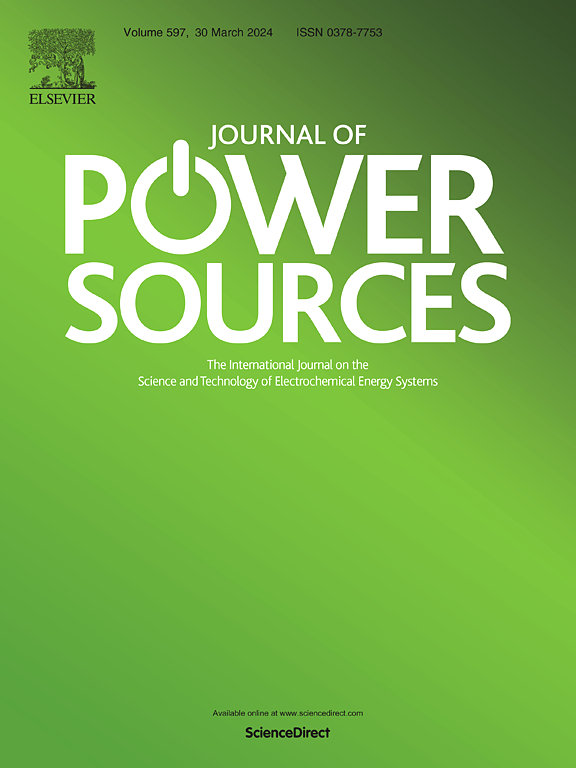Enhanced hydrogen generation through electrodeposited non-precious metal Zn/Cu-BTC metal-organic frameworks on indium tin oxide
IF 8.1
2区 工程技术
Q1 CHEMISTRY, PHYSICAL
引用次数: 0
Abstract
The production of high-purity hydrogen for primary energy generation is a key goal in the renewable energy consumption model. Currently, hydrogen production through electrolysis remains quite expensive, making the development of new non-noble metal catalysts for the cathodes of acidic electrolyzers a promising strategy to lower the costs associated with this technology. In this work, Cu, Zn and Zn/Cu particles in the absence and the presence of 1,3,5-benzenetricarboxylic acid (BTC) have been synthesized via binder-free electrodeposition onto an indium tin oxide (ITO) surface as electrocatalysts to improve the hydrogen evolution reaction (HER) in acidic media. Main results highlight the fundamental role of the metal-organic framework (i.e., BTC), combined with the synergistic effect of both metal elements (i.e., Zn and Cu), in creating a uniform deposition of small crystalline particles on the ITO surface. Consequently, a low-cost and robust electrocatalyst (Zn/Cu-BTC/ITO) with enhanced catalytic performance toward the HER was synthesized. Finally, this work emphasizes how electrochemically modified surfaces, created using low-cost metals and straightforward sustainable synthesis methods, can generate atomically dispersed active sites that enhance both electrocatalytic activity and stability. This approach could contribute to the development of innovative electrodes, improving performance while reducing the cost of electrolyzers.
在氧化铟锡上电沉积非贵金属Zn/Cu-BTC金属有机骨架增强制氢
生产用于一次能源生产的高纯度氢气是可再生能源消费模式的关键目标。目前,通过电解制氢仍然相当昂贵,因此开发用于酸性电解槽阴极的新型非贵金属催化剂是降低该技术相关成本的有希望的策略。在酸性介质中,采用无粘结剂电沉积的方法在氧化铟锡(ITO)表面合成了1,3,5-苯三羧酸(BTC)存在和不存在情况下的Cu、Zn和Zn/Cu颗粒作为电催化剂,改善了析氢反应(HER)。主要结果强调了金属有机框架(即BTC)的基本作用,结合两种金属元素(即Zn和Cu)的协同效应,在ITO表面上形成均匀沉积的小晶体颗粒。因此,合成了一种低成本、性能良好的电催化剂(Zn/Cu-BTC/ITO)。最后,这项工作强调了使用低成本金属和直接可持续合成方法创建的电化学修饰表面如何产生原子分散的活性位点,从而提高电催化活性和稳定性。这种方法可以促进创新电极的发展,提高性能,同时降低电解槽的成本。
本文章由计算机程序翻译,如有差异,请以英文原文为准。
求助全文
约1分钟内获得全文
求助全文
来源期刊

Journal of Power Sources
工程技术-电化学
CiteScore
16.40
自引率
6.50%
发文量
1249
审稿时长
36 days
期刊介绍:
The Journal of Power Sources is a publication catering to researchers and technologists interested in various aspects of the science, technology, and applications of electrochemical power sources. It covers original research and reviews on primary and secondary batteries, fuel cells, supercapacitors, and photo-electrochemical cells.
Topics considered include the research, development and applications of nanomaterials and novel componentry for these devices. Examples of applications of these electrochemical power sources include:
• Portable electronics
• Electric and Hybrid Electric Vehicles
• Uninterruptible Power Supply (UPS) systems
• Storage of renewable energy
• Satellites and deep space probes
• Boats and ships, drones and aircrafts
• Wearable energy storage systems
 求助内容:
求助内容: 应助结果提醒方式:
应助结果提醒方式:


